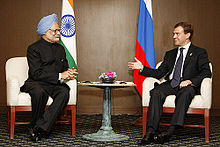Jointly developed by Sukhoi and Hindustan Aeronautics, the Su-30 MKI"Flanker-H" is the Indian Air Force's prime air superiority fighter.
Since its independence in 1947, India has maintained cordial relationships with most nations. In the 1950s, it strongly advocated for the independence of European colonies in Africa and Asia and played a pioneering role in the Non-Aligned Movement. India was involved in two brief military interventions in neighbouring countries – the Indian Peace Keeping Force in Sri Lanka and Operation Cactus in Maldives. India has a tense relationship with neighbouring Pakistan and the two countries went to war in 1947 and 1965 over the Kashmir dispute. After the Sino-Indian War and the 1965 war, India's relationship with the Soviet Union warmed and continued to remain so until the end of the Cold War. In 1971, a third war broke out between India and Pakistan which resulted in the creation of Bangladesh (then East Pakistan). Additional skirmishes have taken place between the two nations over the disputed Siachen Glacier. In 1999, India and Pakistan fought an undeclared war over the Kargil district.
In recent years, India has played an influential role in the SAARC and the WTO. India has provided as many as 55,000 Indian military and police personnel to serve in thirty-five UN peacekeeping operations across four continents. India is also an active participant in various multilateral forums, particularly the East Asia Summit and the G8+5. Recent overtures by the Indian government have strengthened relations with the United States and the People's Republic of China. In the economic sphere, India has close relationships with other developing nations in South America, Asia and Africa.
India and Russia share an extensive economic, defence and technological relationship. Shown here is PM Manmohan Singh with President Dmitry Medvedev at the 34th G8 Summit.
India maintains the third-largest military force in the world, which consists of the Indian Army,Navy, Air Force and auxiliary forces such as the Paramilitary Forces, the Coast Guard, and the Strategic Forces Command. The official Indian defence budget for 2010 stood at US$31.9 billion (or 2.12% of GDP). According to a 2008 SIPRI report, India's annual military expenditure in terms of PPP stood at US$72.7 billion. The President of India is the supreme commander of the Indian Armed Forces. India maintains close defence cooperation with Russia, Israel and France, who are the chief suppliers of arms. Defence contractors, such as the Defence Research and Development Organisation (DRDO) and Hindustan Aeronautics (HAL), oversee indigenous development of sophisticated arms and military equipment, including ballistic missiles, fighter aircraft and main battle tanks, to reduce India's dependence on foreign imports.
China's repeated threats to intervene in the 1965 war in support of Pakistan convinced India to develop nuclear weapons to counter Chinese nuclear tests. India conducted its first nuclear weapons test in 1974 and carried out further underground testing in 1998. Despite criticism and military sanctions, India has consistently refused to sign the CTBT and the NPT which it considers to be flawed and discriminatory. India maintains a "no first use" nuclear policy and is developing nuclear triad capability as a part of its "minimum credible deterrence" doctrine. On 10 October 2008, a civilian nuclear agreement between India and the United States was signed, prior to which India received waivers from the IAEA and the NSG which ended restrictions on nuclear technology commerce and recognised India as the world's sixth de facto nuclear weapons state. Following the NSG waiver, India has also signed civilian nuclear energy cooperation agreements with other nations including Russia, France, the United Kingdom, and Canada.


No comments:
Post a Comment